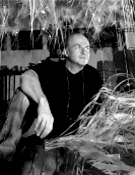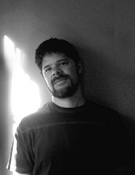Philip Beesley, MRAIC OAA

With the Hylozoic Ground project, Philip Beesley is demonstrating how buildings in the future might move, and even feel and think. In a series of installations that have attracted global attention, Beesley is leading a group of experts from science and art in creating a uniquely Canadian experimental architecture. Beesley is a professor at the School of Architecture, University of Waterloo and is principal of the Toronto design collective PBAI. Accomplishments in the last three decades include numerous public buildings, sculpture, and landscape installations.
Beesley's work is widely published and exhibited. Projects this past year have included installations in Madrid, Linz, Enschede, Brussels, New York, Los Angeles, New Orleans, and most recently at the COP15 Copenhagen climate summit. Beesley has given keynote presentations across Canada and in Los Angeles, Philadelphia, New York, London, Amsterdam, Copenhagen, and Linz. His work has also appeared in Barcelona, Beijing, Tokyo, and Taipei and has been featured in WIRED and MARK magazine and journals including the covers of LEONARDO and ARTIFICIAL LIFE.Distinctions for his work include the Prix de Rome in Architecture (Canada), 1st prize at Spain's VIDA 11.0, a Far Eastern International Digital Architectural Design Award (FEIDAD), and two Dora Mavor Moore Awards.
Philip Beesley holds degrees summa cum laude in visual art at Queen's University, in technology at Humber College, and in architecture at the University of Toronto.
Dr. Rachel Armstrong, MA [Cantab] BMBCh [Oxon]

Dr. Rachel Armstrong is leading the Hylozoic Ground team in developing its ground-breaking 'Living Architecture' chemical circulation systems. She is a Global TED Fellow, Teaching Fellow at the Bartlett School of Architecture, University College London and member of Professor Neil Spiller's AVATAR Research Group. Armstrong is an interdisciplinary practitioner with a background in medicine who collaborates extensively with artists, scientists and architects to create new experimental spaces that re-engage with the fundamental creativity of science.
Dr. Armstrong emphasizes the unique role that architecture occupies within the cultural imagination, offering an ideal forum to reimagine our experience of the world so that we can reinvent our role within it. Her highly acclaimed research on building systems demonstrates how buildings can share properties of living systems.
Martin Hanczyc
Associate Professor Martin Hanczyc is the scientific designer and developer of the protocell technology that underpins the 'living' chemistry of the Hylozoic Ground's innovative blend of different artificial life species. Hanczyc is Associate Professor at the Institute of Physics and Chemistry and the center for Fundamental Living Technology (FLinT) in Denmark. He is also a Honorary Senior Lecturer at the Bartlett School of Architecture, University College London. He is developing novel synthetic chemical systems based on the properties of living systems. These synthetic systems are often termed 'protocells' as they are model systems of primitive living cells and chemical examples of 'artificial' life. Particilarly of interest is the development of dynamic and responsive materials of simplistic composition. He has previously also held the position of Laboratory Director at The European Center for Living Technology in Venice, Italy and Chief Chemist at ProtoLife Srl in Venice, Italy. He received a bachelor's degree in Biology from Pennsylvania State University, a doctorate in Genetics from Yale University and was a postdoctorate fellow under Jack Szostak at Harvard University. Martin is interested in the development of protocell models into new technologies and their applications in art and design.
Dr. Rob Gorbet, PEng

Collaborator Dr. Rob Gorbet is an Associate Professor at the University of Waterloo's Centre for Knowledge Integration and the Department of Electrical and Computer Engineering. He is also a key member of Gorbet Design, a Toronto-based design firm and consultancy specializing in public interactive artwork and experiences. His interdisciplinary expertise includes mechatronics, advanced technology, and visual art.
Gorbet is an award-winning teacher, interested in the design of interactive artworks and the process of learning across disciplines. His current engineering research focuses on modelling and control of actuators made of shape memory alloys (SMA), and the specialized development of a new generation of sensing and actuation systems emphasizing tune and subtle motion connoting empathy.
Gorbet's collaborative interactive artworks have been exhibited across Europe and North America, including ISEA2006 in San Jose, the Matadero Madrid, the Ars Electronica Centre in Linz, and the Beaux Arts in Montreal. His works have won several awards, including a 2008 FEIDAD Design Merit award and the prestigious Primer Premio at the VIDA 11.0 competition in 2009. They have been featured in major print media including Wired Magazine, Domus, Leonardo, and on the Discovery Channel's Daily Planet.
Hayley Isaacs
Hayley Isaacs is a professional visual artist and architect, specializing in time-based new media installations. She is an award-winning graduate of the Masters program at the University of Waterloo School of Architecture. Isaacs has worked at several architecture firms in Canada, the United States, and abroad as a graphic artist and architectural designer. Isaacs has been a member of the PBAI collective working with Philip Beesley since 2007. She has been heavily involved in the design of interactive sculptures and architecturally-scaled installations, including the first prize-winning VIDA installation Hylozoic Soil, which has been exhibited in Austria, Madrid, Mexico City, and Montreal; and Endothelium, exhibited at the California NanoSystems Institute in November, 2008. Isaac is currently design director for the Hylozoic Ground project. Isaacs is also the general manager of Riverside Architectural Press (RAP), supervising production and dissemination of design and research publications. She was artistic director and graphic artist for three of RAP's newest publications, Ourtopias, Maison Solaire, and North House.
Pernilla Ohrstedt
Pernilla Ohrstedt is a London-based architect. She received her M.Arch. from the Bartlett School of Architecture, University College London. From 2007-2008, Ohrstedt was the producer of Storefront for Art and Architecture, New York, where she was in charge of the conceptualization, design and production of exhibitions, installations, and events, as well as being extensively involved in programming and curatorial work. Ohrstedt was co-originator (with Joseph Grima) of Storefront's first exhibitions program outside New York, the Storefront Pop-Up series, conceived to open dialogue with cities and institutions around the world. She has worked in several architecture practices, most notably Future Systems in London, founded by Czech architects Jan Kaplicky and Amanda Levete. Ohrstedt's academic work has been recognized with several awards and prizes, including the Leverhulme Trust Grant for Innovative and Interdisciplinary Work of Outstanding Potential. Her dissertation In Between Before and After-Exploring the Commodification of the Ideal was awarded with the University College London prize for distinguished work in history and theory. She was awarded commendation for both her design and thesis work, which explore the notion of a 'hypervisceral' architecture, in the realm of the Eros statue on Piccadilly Circus in London.

